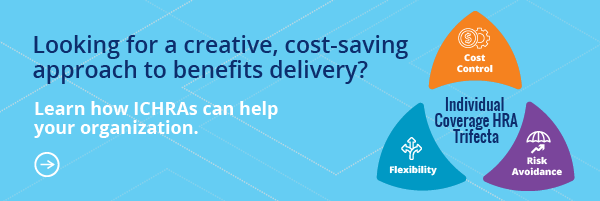For many years, a defined contribution approach to healthcare has been a pie-in-the-sky proposition.

Employers and benefits consultants considered it, but only in the abstract.
However, whether you love or hate the concept, it’s now a bona fide option. The new Individual Coverage Health Reimbursement Arrangements (ICHRAs) enable employers to set up and fund notional accounts for employees to purchase their own healthcare coverage with any amount the employer determines. (There are some funding nuances around age but that’s about it.)
Employers are in the healthcare business, and it's expensive.
The stakes are high. Approximately half the US population is covered under employer-sponsored healthcare, and employers invest as much on this coverage as the Federal government spends on Medicare and Medicaid combined—around $1.2 trillion annually.
Given the order of magnitude, it’s clear that American employers are solidly in the healthcare business, and they have the ever-growing price tag to prove it. While medical cost trends have been flat for the last two years, at 5.7% they are still rising more quickly than inflation and are projected to tick up to 6% in 2020.
This is a compelling reason for employers to find innovative ways to offer high-value healthcare coverage as cost-effectively as possible. Given the amount of spend on the table, some employers have taken matters into their own hands by directly negotiating contract prices, setting up their own provider networks and even establishing parallel health systems.
Wellness programs and healthcare costs - are they related?
These activist interventions are still the domain of the few, but one popular trend-bending technique is wellness programs. The theory is the healthier employees are, the less healthcare they will use. Research to prove this proposition hasn’t been conclusive, but most employers are still willing to try.
Wellness certainly doesn’t come cheap. In 2019 large employers were projected to spend an average of $3.6 million on their wellness programs, with a good portion of that going to financial incentives. This includes an average $762 per-employee and $601 per-spouse incentive.
One appeal of ICHRAs is that employers that leverage them effectively are able to reduce risk and provide health benefits at a fixed cost. Employees pick their own individual plan and the insurer is on the hook for claims liability.
But even if an organization chooses to exit healthcare, having a healthy and happy workforce is still of utmost importance. Knowing that, the need for wellness programs will likely not go away.
A holistic view on wellness continues to take hold.
Wellness has been gaining in importance in the last few years and has morphed into a more holistic perspective on employee well-being that is tied to overall productivity and morale, not to mention recruitment and retention. This includes not only physical health, but also employees’ emotional and financial health.
Most employees are interested in having a wellness program at work and they feel it positively impacts their health. People are also more loyal to organizations they feel care for their financial well-being and would be attracted to a potential employer that demonstrated more focus in this area.
It’s important to note, that insurers are interested in managing costs and many have their own wellness programs. So, employees with individual coverage through an ICHRA may be eligible to participate as part of their coverage.
Insurers can't mirror a workplace's wellness culture.
However, insurers can’t replicate an employer’s overall culture of wellness, which may be an important part of the employee value proposition and the organization’s overall brand.
ICHRAs offer employers an innovative and cost-effective new approach to offering healthcare benefits. As organizations look to these new accounts as a genuine option, they will need to fully consider the programs that need to be aligned alongside them, such as wellness, in order to support holistic well-being among their workforce.
These are perks that the workforce values and that may increase employee engagement.
And, considering the challenges employers have in attracting and retaining top talent in this labor market, anything that offers a competitive advantage—including wellness programs—should continue to be supported.



